Linear interactive and transactional models of communication. There are three types of communication models: linear, Interactive, and Transactional.
List of Contents
Communication Models
Communication models refer to the conceptual frameworks or theories that explain human communication. It also represents the entire communication process between the sender and the receiver. The communication model tries to answer the 5Ws and 1H questions regarding the communication process; for example, what is communication? Who is involved in this process? When does it happen? Where does it take place? Why does it occur? And finally, how does the communication happen?
Additionally, communication models contribute to the development of many other theories and models. For example, communication models form the basis of mediated communication technology adoption models.
Furthermore, communication models explain the elements of the communication process, for example, context, sender, receiver, encoding, decoding, channel, message, feedback, and noise. These are the components of communication that describe the entire process. However, some communication models lack all these elements or features. For example, the linear model of communication lacks feedback. The communication model also explains the factors that prevent effective communication, known as barriers or noise: these hinder effective communication processes.
Linear Interactive and Transactional Models of Communication
Three Types of Communication Models are:
- Linear Models of Communication
- Interactive Models of Communication
- Transactional Models of Communication
The three types of communication models are linear, interactive, and transactional. The examples of linear, interactive, and transactional communication models have been illustrated, including the established years and elements.

1. Linear Models of Communication
The linear communication model is a one-way interaction in which feedback is absent. Linear is the primary communication model, whereas the transactional model is built on it. The sender communicates with the receiver without receiving feedback. It also represents a one-way communication process.
Many scholars have established linear communication models, such as Aristotle’s, Shannon-Weaver’s, Lasswell’s, and Berlo’s SMCR Model of Communication.
Linear Model of Communication Example
| Communication Models | Year |
| Aristotle’s Model of Communication. | 300BC |
| Lasswell’s Model of Communication. | 1948 |
| Shannon-Weaver Model of Communication. | 1949 |
| Also, Berlo’s SMCR Model of Communication. | 1960 |
2. Interactive Models of Communication
The interactive communication model refers to the two-way method of communication with feedback. However, feedback is not simultaneous, resulting in slow, indirect feedback. Sometimes communication can be linear when the receivers do not reply to the senders. The interactive model of communication indicates mediated and internet-based communication.
For example, Osgood-Schramm, Westley, and Maclean are interactive communication models.
Interactive Model of Communication Example
| Two-Step Flow of Communication Model | 1944 |
| Osgood-Schramm Model of Communication | 1954 |
| Westley and Maclean’s Model of Communication | 1957 |
3. Transactional Models of Communication
The transitional communication model appears to be a two-way process with immediate feedback. Simultaneous feedback is the essential component of the transitional models of communication. So, the communication process will not become transactional without feedback. The feedback is direct and very fast. The receiver is compelled to provide instant feedback. The significant difference between the interactive and transactional models lies in the provision of indirect and direct feedback.
For example, Wilbur Schramm’s model of communication, Barnlund’s transactional model of communication, Dance’s Helical model of communication, and Eugene White’s communication model are transitional communication models.
Transactional Model of Communication Example
| Eugene White’s Model of Communication | 1960 |
| Dance’s Helical Model of Communication | 1967 |
| Also, Barnlund’s Transactional Model | 1970 |
Examples of Three Types of Communication Models
Examples of linear, interactive, and transactional communication models are Aristotle’s Model of Communication, Lasswell’s Model of Communication, Shannon–Weaver’s Model of Communication, Berlo’s Model of Communication, Osgood-Schramm Model of Communication, Westley and Maclean’s Model of Communication, Barnlund’s Transactional Model, Eugene White’s Model, and also, Dance’s Helical Model of Communication.
Linear Models of Communication
1. Aristotle’s Model of Communication
Aristotle’s communication model comprises the elements of speaker, speech, occasion, audience, and effect. In 300 BC, Aristotle developed a linear communication model that focused mainly on the speaker and the message. Controversially, it is also known as the first model of communication. Aristotle’s communication model comprises five primary communication elements: speaker, speech, occasion, audience, and Effect. The speaker plays a crucial role in communication because they set the message to deliver. However, the speaker’s speech may depend on the occasion.
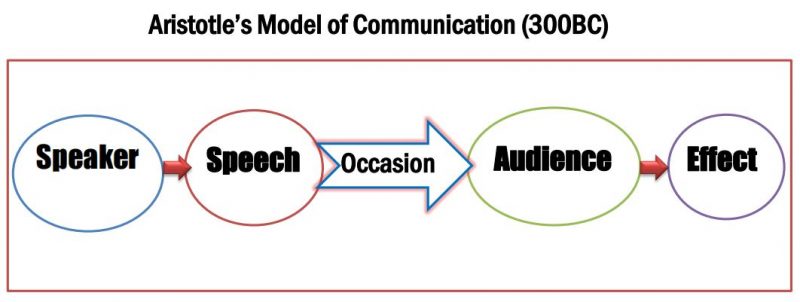
For example, a political leader (speaker/sender) delivers a speech to persuade voters to vote for him. The political leader is the most crucial person who provides the message or information. The speech is the leader’s message to influence the voters to vote for him. The election is the occasion, and the speaker’s speech or message varies depending on the event. Political leaders might not deliver the same kind of speech before and after the election. Finally, the effect refers to voters’ motivation to vote for him.
2. Lasswell’s Model of Communication
Political scientist and professor Harold Lasswell introduced Lasswell’s communication model in 1948. It is a linear model of communication that also represents the style of one-way communication or interaction. Lasswell’s model explains the communication process by answering the following questions: who says what, in which channel to whom, and with what effect?
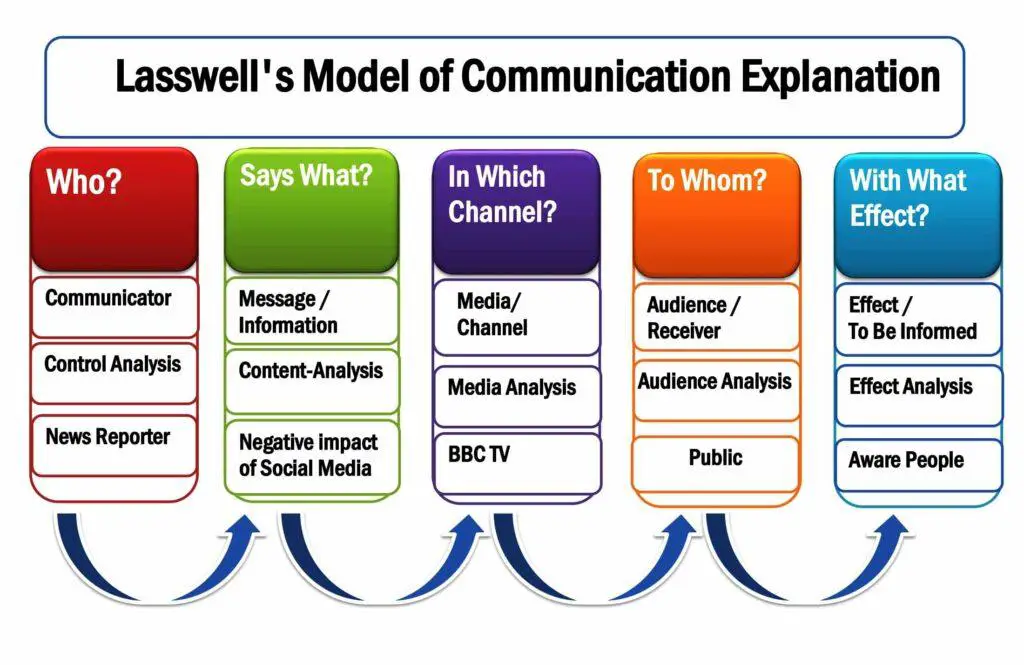
Example of Lasswell’s Model of Communication
For example, the BBC News channel has reported on the negative impact of social media in spreading fake and misleading information. It also shows how social media can affect people physically and mentally. Finally, they offer tips on how to stop spreading fake and disinformation on social media. Based on the set of questions outlined by Lasswell’s communication model and the example, firstly, the answer to “Who” is the BBC News Channel news presenter. Secondly, it says that people use social media to spread fake and misleading information. Thirdly, the answer to the “In which Channel” question means the BBC News Channel. Additionally, “To Whom” refers to the people watching this channel. Finally, with what effect does the awareness have?
3. Shannon and Weaver’s Model of Communication
Shannon-Weaver’s communication model was established by two American scholars, Shannon and Weaver, in 1949. The Shannon-Weaver model is called the mother of all communication models. Shannon and Weaver did not include feedback; therefore, it is a linear communication model. However, Norbert Weiner added Feedback to the model in response to the criticism. At first, this model was designed to articulate the technical communication process. Later, it was used to discuss all types of communication. The Shannon-Weaver model represents six essential communication elements: information source, transmitter, channel, receiver, destination, and noise source. This model does not represent feedback; therefore, it is a linear communication model. Later, this model was criticized by many other scholars for not having feedback. Feedback is vital in making the communication process more interactive and practical. However, Norbert Weiner added the Feedback element to the model.
Shannon–Weaver Model of Communication Example
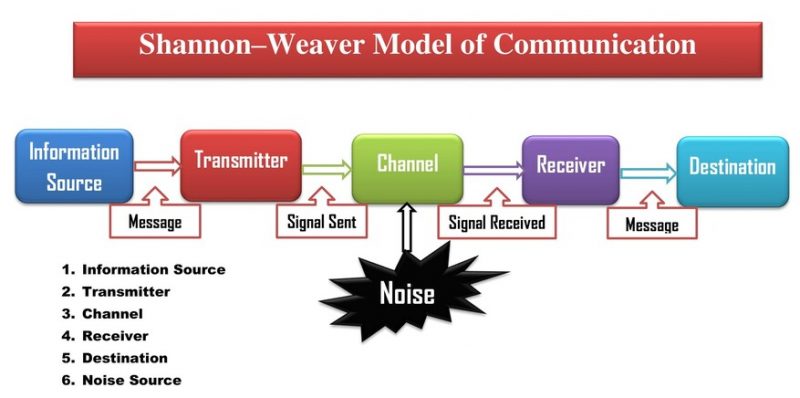
4. Berlo’s Model of Communication
Berlo’s Model of Communication is the SMCR model, which includes the elements Source, Message, Channel, and Receiver. David Berlo developed the Source-Message-Channel-Receiver in 1960. It is also known as the David Berlo SMCR model of communication. However, Berlo invented this model based on the Shannon-Weaver communication model (1949). The four elements of David Berlo’s SMCR communication model are the source, message, channel, and receiver. Berlo focuses on both verbal and nonverbal communication elements to convey information.
David Berlo’s SMCR Model of Communication Example
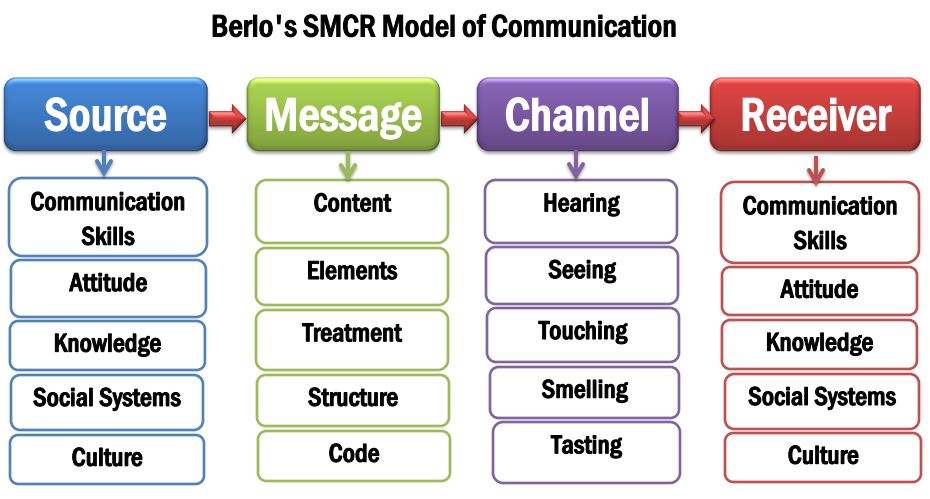
Interactive Models of Communication
5. Two-Step Flow of Communication Model
The two-step flow of communication is a well-known interactive model in the field of mass communication. The three veteran scholars Paul Lazarsfeld, Bernard Berelson, and Hazel Gaudet developed the two-step flow of communication model in 1944. It is not a linear communication model; instead, the two-step flow theory is an interactive model of communication. The media disseminates messages to opinion leaders, who are the gatekeepers, conveying information to society and the community. There are multiple steps in this communication process; therefore, it is an interactive model. The feedback exists in multi-step conversations.
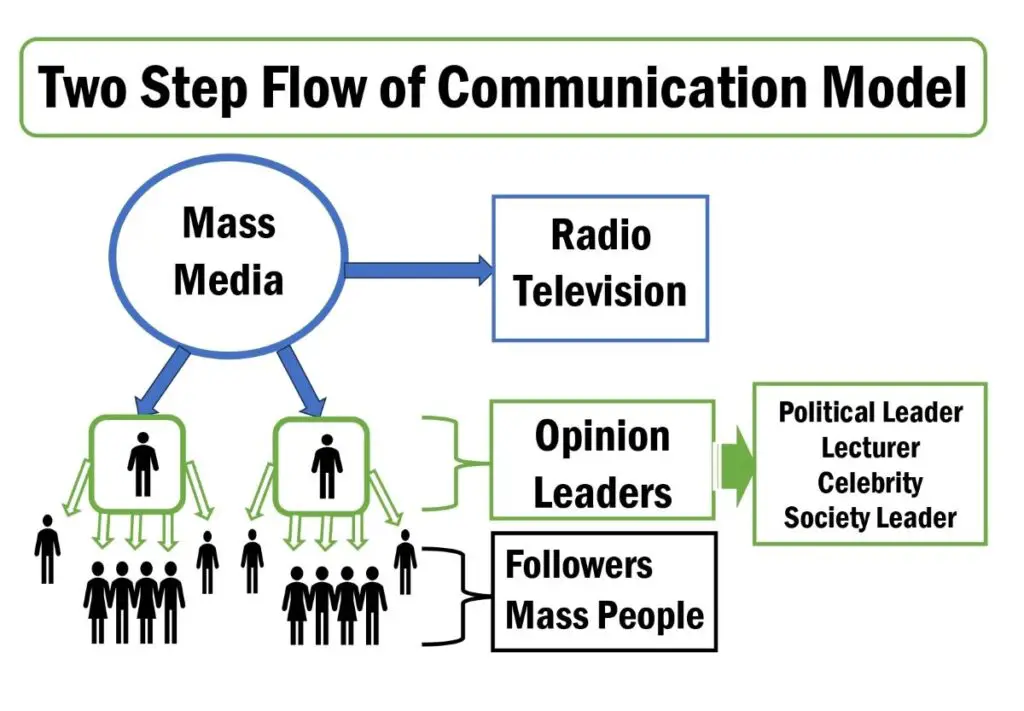
6. Osgood-Schramm Model of Communication
The Osgood-Schramm Model provides a two-way form of communication. However, Wilbur Schramm adopted the concept from the theory of another scientist, Charles Egerton Osgood. Osgood proposed that the communication process is circular rather than linear. So, the person plays both the sender and receiver roles in the message. The person receives the message and interprets it, then provides feedback. Therefore, it is known as the Osgood-Schramm Model of communication.
The elements of the Osgood-Schramm Model are Interpreter, Encode, Decode, and Message.
Osgood-Schramm Model of Communication Example
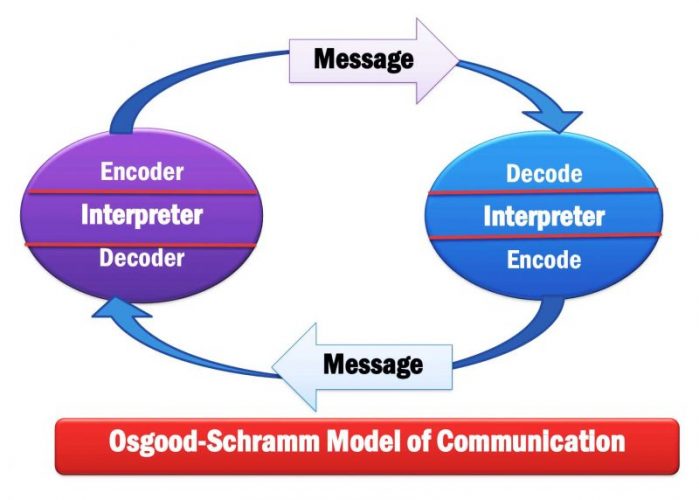
7. Westley and Maclean Model of Communication
Westley and Maclean’s interactive communication model examines the communication process between sender and receiver. Bruce Westley and Malcolm S. MacLean Jr. established the model in 1957. Westley and Maclean’s communication model was adapted from Newcomb’s communication and Lewin’s change management model. It represents the two-way communication process, so feedback is essential in this model. It also explains interpersonal and mass communication. Feedback is indirect and slow in mass communication, whereas it is direct and fast in interpersonal communication. According to Westley and Maclean’s model, A represents the sender, B represents the receiver, and C represents mass media. The interactive communication process is more effective than linear communication.
Transactional Models of Communication
8. Eugene White’s Model of Communication
There are eight stages of the oral communication process: thinking, symbolizing, expressing, transmitting, receiving, decoding, feedback, and monitoring. So, communication is a sequential interaction process; however, it cannot determine the receiver’s active role in the continuous communication process.
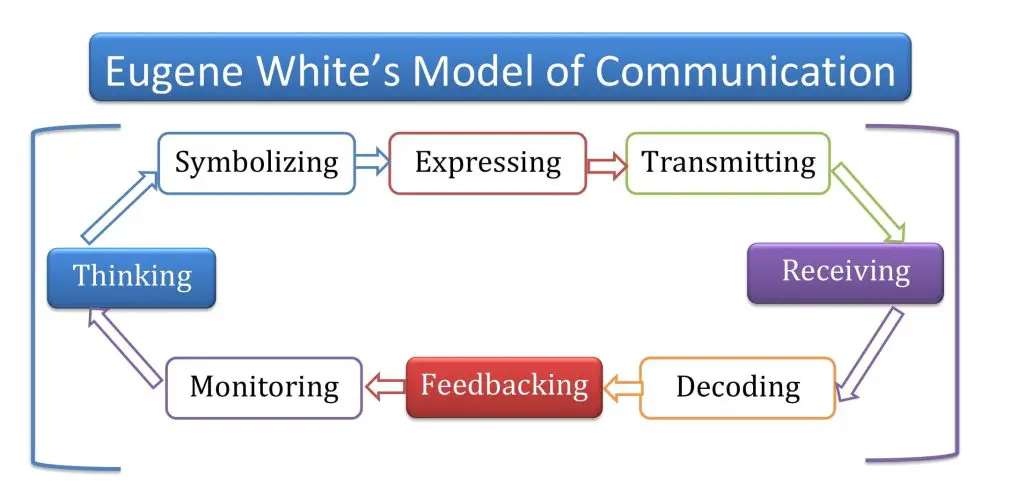
9. Dance’s Helical Model of Communication
In 1967, Frank Dance introduced the transactional communication model called the Helical communication model. The author initially named Dance’s Helix communication model. Frank Dance used helix to develop the complex communication process model. The word helical comes from the helix, meaning spiral staircase. Communication becomes more extensive as it grows like a helix. Communication is an evolutionary and dynamic process with feedback.
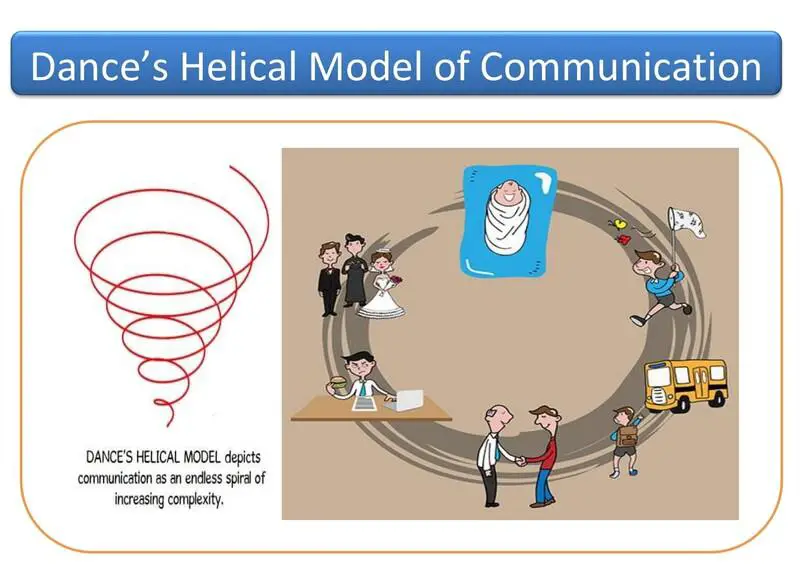
Any communication starts with a small circle, where the communicators share little about themselves. Communication expands boundaries when people share more personal information. Finally, the relationship grows gradually to reach the top level.
10. Barnlund’s Transactional Model
In 1970, Dean Barnlund introduced the transactional communication model. The author formed this model based on public, private, and behavioral cues. Barnlund’s transactional model refers to the multi-layered communication process with feedback. The sender and receiver exchange roles for effective communication; therefore, the sending and receiving of messages occur reciprocally between the sender and receiver. The eight elements of Barnlund’s communication model are person, encoding, decoding, public cues, private cues, verbal cues, behavioral cues, nonverbal cues, and message.

Importance of Models of Communication
Communication models are essential tools for understanding communication processes. It provides detailed information on the communication process and illustrates its flow. Therefore, they have a tremendous positive impact on the research by introducing many conceptual frameworks of communication processes. Additionally, the model presents the elements of the communication process. Furthermore, the communication model provides tips for effective communication. They represent the barrier or noise that obstructs the process of communication. They also explain the complexities of the communication system. Finally, these three communication models propose ways to improve the communication process to avoid conflict.
Linear Interactive and Transactional Models of Communication
1. Linear Model: The linear communication model simplifies the process into a one-way flow from sender to receiver. Here, the sender encodes a message, which is then transmitted through a channel to the receiver, who decodes it. Feedback is minimal, it is not present at all, and there’s little room for interaction or dialogue. This model is akin to a broadcast, where information is sent without much expectation of response or engagement.
2. Interactive Model: The interactive model introduces feedback and two-way interaction by expanding upon the linear model. It acknowledges that communication is a dynamic process involving encoding, decoding, and response from both parties. Feedback becomes essential for clarifying, validating, and adjusting messages. Communication is viewed as a reciprocal exchange that allows engagement and dialogue between the sender and receiver.
3. Transactional Model: The transactional model sees communication as a complex, ongoing process influenced by various factors. Here, communication is simultaneous, with both parties acting as sender and receiver. Messages are not merely transmitted but co-created through interaction and negotiation. Context, culture, and personal experiences shape the meaning of messages, which are subject to interpretation and reinterpretation from both parties’ perspectives.
Linear Interactive and Transactional Model Differences
|
Linear Model of Communication |
Interactive Model of Communication |
Transactional Model of Communication |
| One-way communication | Two-way communication | Two-way communication |
| No Feedback | Feedback Available | Instant Feedback Available |
| Unreciprocated | Reciprocal | Reciprocal |
Conclusion
In conclusion, the most common linear interactive and transactional communication models are Aristotle’s Model, Shannon-Weaver Model, Lasswell’s Model, Berlo’s SMCR Model, Osgood-Schramm Model, Westley and Maclean’s Model, Wilbur Schramm model, Barnlund’s Transactional Model, Dance’s Helical Model, and Eugene White’s Model of Communication. The 3 types of communication models are linear, interactive, and transactional.
These models provide different perspectives on how communication occurs, from the linear transmission of information to the interactive exchange of meaning and the transactional co-creation of messages. Each model offers insights into the dynamics of communication and highlights the importance of feedback, interaction, and context in the process.
Citation For This Article (APA 7th Edition)
| Kobiruzzaman, M. M. (2025). Linear Interactive and Transactional Models of Communication. Newsmoor. https://newsmoor.com/3-types-of-communication-models-linear-interactive-transactional/ |
Nice Post
Great
Nice post
This content is very useful and easy to understand it.Have loved the work.
Level
Thank you for this useful infomration.
This article is awesome and quiet understandable